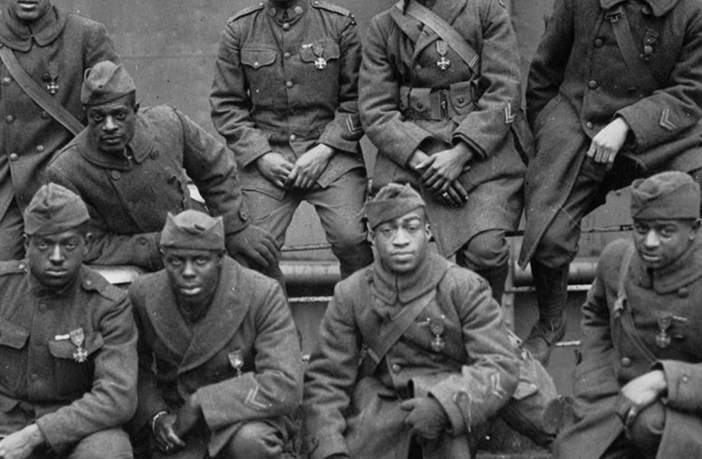Blacks have a long and storied history of military service, fighting enemies abroad and on American shores. Members of the Harlem Hellfighters, 369th Infantry Regiment, WWI. Courtesy National Archives.
As has been stated often, Blacks have fought in every American war since the American Revolution.
The U.S. Army History Office estimates roughly 5,000 Blacks fought on the side of the colonists in the American Revolution, serving in the artillery (the most advanced branch of service during the period), the infantry, as laborers and even musicians.
What’s even more telling about Black military service is that during the war for America’s independence, more Blacks fought on the side of the British than with George Washington and crew.
Michael Harriot, in his New York Times bestselling book “Black AF History: The Unwhitewashed Story of America” and in countless Griot.com articles, contends Black people have always fought for Black people.
Revolutionary War
 Drawing of a Black Loyalist (member of the British Ethiopian Regiment). Courtesy Wikimedia Commons.
Drawing of a Black Loyalist (member of the British Ethiopian Regiment). Courtesy Wikimedia Commons.
“Approximately 5,000 Black men fought for America in the Revolutionary War; more than 20,000 fought against America,” wrote Harriot in a July 2023 Griot article. “Even the Black Loyalists in the American Revolution were not fighting to preserve the British empire. They were fighting for their freedom.”
This consistent thread runs through every battle in which America has engaged from the 1700s to the present.
During the Civil War, Blacks literally fought for their freedom, siding with Union forces, or fought to keep from being tortured and killed, forced to accompany their Confederate enslavers to those battlefields.
Seminole and Spanish-American Wars
 Descendants of Black Seminoles. Courtesy Black Girls Rock.
Descendants of Black Seminoles. Courtesy Black Girls Rock.
During the Seminole Wars (1816-1818; 1835-1842; and 1855-1858), multiple scholars contend Blacks who had emancipated themselves from slavery and lived as Maroon communities with the Seminoles indigenous to Florida, fought U.S. troops to multiple standstills. Again, Black military service focused on Black freedom.
The Buffalo Soldiers came to prominence during their service in the Spanish-American War (1898).
“Many argue they were fighting on the wrong side, with their oppressors and against their indigenous brothers and sisters,” said Howard University professor Dr. Greg Carr, during a recent episode of the Karen Hunter-hosted podcast, “In Class with Carr.”
Still, their goal extended beyond honoring the “Red, White and Blue,” to serving as a vehicle for desired equality.
Many saw such service as their opportunity to push for equality at home by supporting their country and fighting abroad.
WWI & Backlash
 Soldiers on trial in the fall of 1917 sit under guard at Fort Sam Houston. The building they were in is now known as the Gift Chapel. Two other trials were held in a different building, a gymnasium, in 1918. Photo courtesy of the U.S. Army.
Soldiers on trial in the fall of 1917 sit under guard at Fort Sam Houston. The building they were in is now known as the Gift Chapel. Two other trials were held in a different building, a gymnasium, in 1918. Photo courtesy of the U.S. Army.
During the Great War, later dubbed World War I, Blacks were credited with defending democracy abroad and celebrated in those foreign lands as heroes and liberators. They hoped to return to an America that was more accepting of their humanity. They found the exact opposite.
According to an article on the Equal Justice Initiative’s website (eji.org): “During the late 19th and early 20th centuries, white supremacy remained law and custom throughout the nation, and many whites feared that Black soldiers who had experienced the pride of military service would resist the disenfranchisement, segregation, and second-class citizenship that still characterized the African American experience. In August 1917, U.S. Senator James Vardaman of Mississippi warned that, once a Black soldier was allowed to see himself as an American hero, it would be ‘but a short step to the conclusion that his political rights must be respected.’ Bringing Black soldiers home to the South with expectations of equality, he predicted, would ‘inevitably lead to disaster.’”
The result: numerous cases of Black veterans lynched in military uniform, most notably the lynching of Wilbur Little in the spring of 1919.
However, Black WWI vets used the same skills applied on battlefields to protect themselves, their families and communities against white domestic terrorism which reached its peak during the Red Summer of 1919.
One such example was the willingness to confront racist injustices here in Houston by Black soldiers which led to the Camp Logan “Riot” of 1917.
WWII and Double V
 Black troops during WWII. AP Photo
Black troops during WWII. AP Photo
Although the United States Armed Forces were officially segregated until 1948, WWII laid the foundation for post-war integration of the military. In 1941, fewer than 4,000 African Americans were serving in the military, and only 12 Blacks had become officers. By 1945, more than 1.2 million Blacks would be serving in uniform on the home front, in Europe and the Pacific, including thousands of Black women in the Women’s auxiliaries.
One of the major themes of WWII in Black circles was their commitment to “Double V,” a campaign established by Black leaders and organizations calling for victory over foreign enemies and victory over American racism.
 Women’s Auxiliary troop members during WWII. Courtesy National Archives.
Women’s Auxiliary troop members during WWII. Courtesy National Archives.
Stephen Ambrose identified the lamentable American irony of WWII, writing, “The world’s greatest democracy fought the world’s greatest racist with a segregated army” (Ambrose, Citizen Soldier).
Scholars credit the “Double V” movement, with its new Black consciousness and defiant rejection of unjustifiable racism, for planting important seeds for the post-war civil rights movement.
Today
 Credit: Adobe Stock.
Credit: Adobe Stock.
Black vets from those past wars, especially those who served in Vietnam, rarely, if ever received their just do. GI Bill benefits being denied to most Black vets, scholars contend, blocked Blacks from a significant wealth-building opportunity, as the GI Bill was known as “the Great Democratizer,” elevating more poor to middle-class status than any other legislation in history.
And despite the general public’s professed love affair with the men and women who served this country in the many branches of the armed services, veterans catch hell in terms of access, or lack thereof, to healthcare and other services.
One of the shameful outcomes of this lack of support is the rate of veteran homelessness, with Black vets bearing the brunt of this reality.
And though Black vets and Blacks in current military spaces are said to experience racism while serving, in dealings with the VA (Almost 80% of employees at Veterans Affairs believe racism is a serious and wide-ranging issue at the agency), at military academies or on the streets, Blacks continue to serve and Black vets continue to push for equality.
Initiatives like Houston Stand Down, an annual event that will enter its fourth decade this fall, seek to provide vets with much-needed support.
The event focuses on connecting vets, especially homeless vets, to food, shelter, clothing, health screenings and VA Social Security benefits counseling. Every year, 75-plus Veteran Services Organizations show up to provide services covering the gamut, “from food insecurities to employment, housing, which is always a big thing with Stand Down,” said Jamay Fishback of Career Gear Houston and co-chair of Houston Stand Down 2023.



